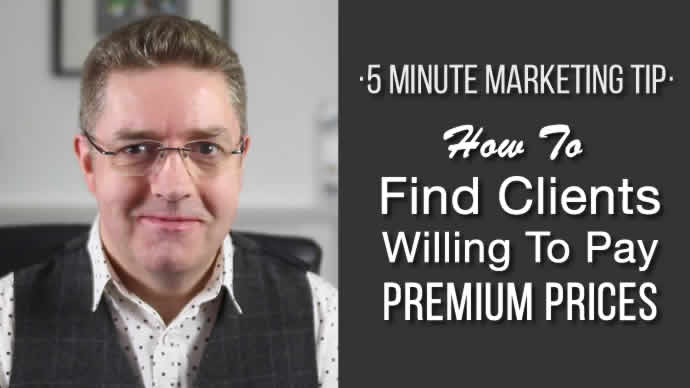Featured
Posted by Ian Brodie on 2nd February 2016.
Ian Brodie on 2nd February 2016.

Being able to charge premium prices for your products and services is a huge advantage. Especially for smaller businesses and individuals where you don't have the scale to make money from a low cost position.
But premium pricing is often easier said than done. One big reason is that many businesses go about it the wrong way. They try to take an existing market or client base and persuade it that their products and services are worth paying a premium for.
That’s possible, but it’s hard work. A better strategy can be to find a segment or sub-segment of the market that’s inherently more willing to pay premium prices and to focus your products and services and your marketing on what that segment wants and needs, rather than what the general market wants and needs.
How do you find those premium segments?
Watch this week's video to find out…
Click here to watch the video »
Featured
Posted by Ian Brodie on 19th January 2008.
Ian Brodie on 19th January 2008.
 There's an excellent article in this weeks Economist. It explores a study by Dr Antonio Rangel of the California Institute of Technology which found that if people are told a wine is expensive while they are drinking it, they really do think it tastes nicer than a cheap one.
There's an excellent article in this weeks Economist. It explores a study by Dr Antonio Rangel of the California Institute of Technology which found that if people are told a wine is expensive while they are drinking it, they really do think it tastes nicer than a cheap one.
It's not that they just say it tastes better, Dr Rangel and his colleagues used functional magnetic resonance imaging to show that the parts of the brain associated with pleasure were stimulated more by the wines thought to be higher priced (they were actually the same wines). And this happened with experienced wine tasters as well as everyday drinkers.
Of course, you could argue that we've known this for years – but it's good to see it backed up by hard science. And it's good to see that it's a real impact on perceived quality (which can therefore influence sales) rather than people just saying they think it's better (which won't have such an impact on sales).
This also ties in well with other approaches often taken to improve sales such as the use of testimonials and referrals. In each case, lacking hard, definitive information about the quality of a product, the customer uses secondary sources: the opinions of others or in this case, the price of the product itself.
Of course, this doesn't work in all situations. If one store prices an i-phone higher than another for example, customers won't assume it's higher quality. They have other, more concrete ways of assessing the (relative) quality of a product – in this case, they're identical because they're the same product.
This gives us useful clues as to where referrals, testimonials, and premium quality pricing can be most useful. If it's difficult for customers to objectively evaluate the product's value themselves, then they will search for other clues as to it's value. It's then when referrals and testimonials – and a premium pricing strategy – come into there own.
Conversely, if your product can be simply evaluated and accurately valued by a customer then you may be better off investing your time on other things than getting testimonials and references. And you may have little choice over how you price the product.
Onward!
Ian



 There's an excellent
There's an excellent